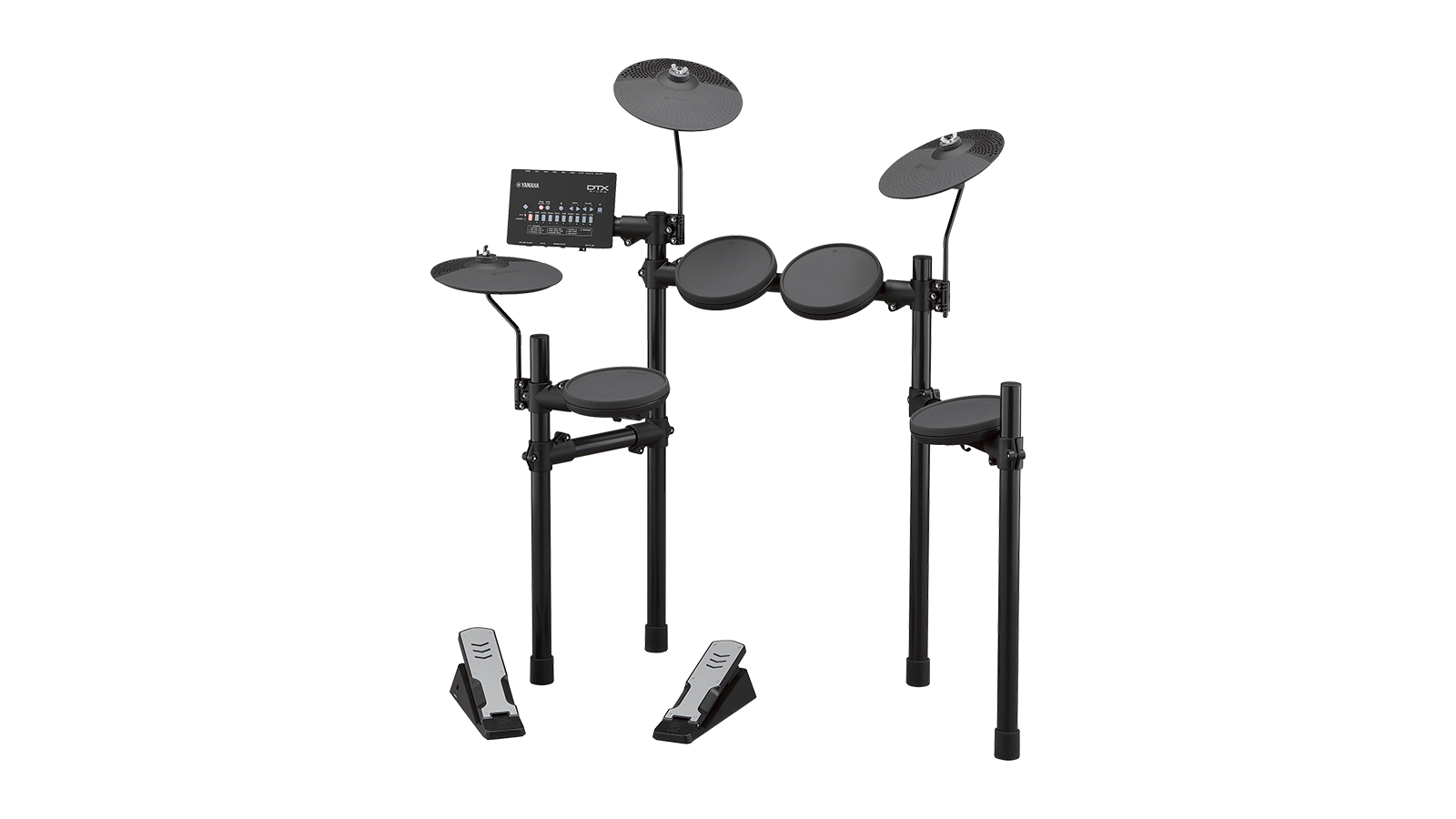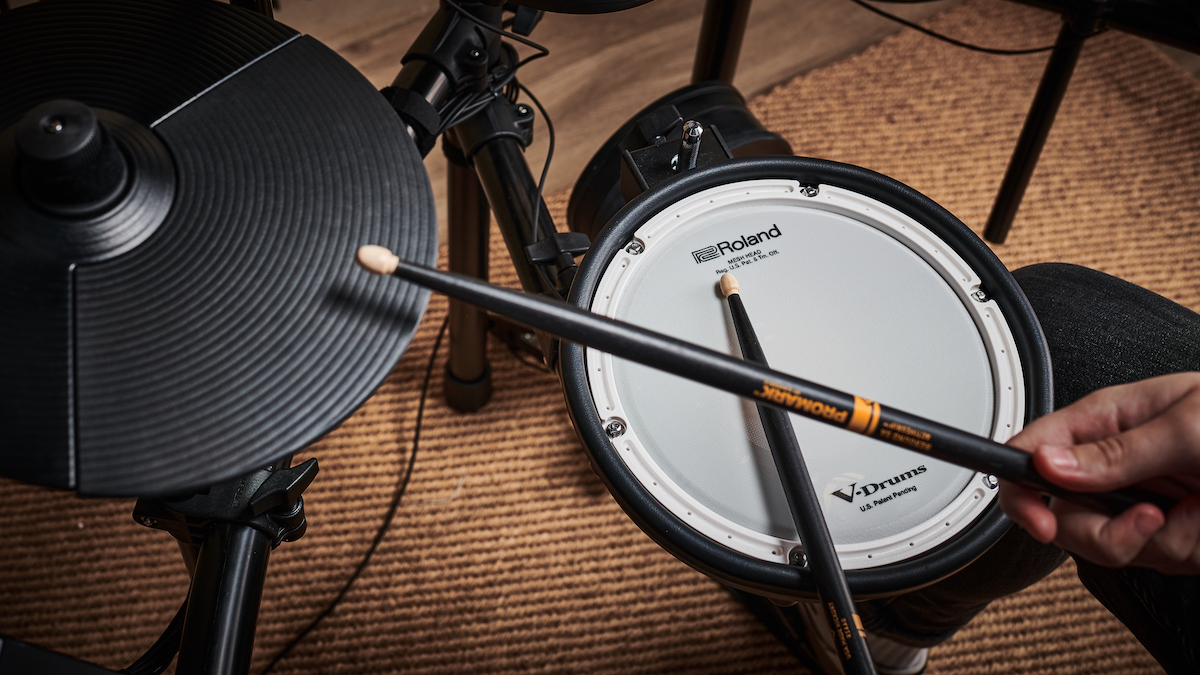Mesh drum heads vs rubber pads: which are better for electronic drummers?
The pros and cons of the two main playing surfaces you’ll find on an electronic drum set

When it comes to choosing an electronic drum kit, one of the biggest decisions you’ll need to make is the type of playing surface you want on your new kit. This breaks down into two main categories – mesh drum heads or rubber pads.
Which of these is right for you will depend on multiple factors, from your budget to the application. So join us as we take a look at the mesh drum heads vs rubber pads debate, and explore some of the key differences between the two most common types of electronic drum pads.
1. Noise
There’s every chance that your decision to use an electronic drum set has been governed by how much noise you can create in the room or building that you’re planning on playing it in. We’ll start by saying that the airborne noise from any electronic set – mesh heads or rubber pads – is going to be considerably quieter than an acoustic drum kit, but hitting a surface with a pair of drumsticks and a beater is still going to make some sound, even if you’re playing on headphones.
Mesh heads are exactly that: a mesh structure with thousands of tiny holes which diffuse the vibrations and air movement we create when striking a pad, lowering the volume of the stick hitting the surface. Rubber pads on the other hand are dense, solid surfaces, and while the noise is dulled in comparison to a harder, plastic surface (we’d suggest you avoid any drum pads of this type), you will get a more audible thud in the room.
What’s more, if you’re playing the kit upstairs, those vibrations will need to travel somewhere. Typically, this will be back into the stick, and through the kit’s rack or pedals, and straight into the floor they’re sat on. Mesh heads = fewer vibrations, which also means less transfer to other rooms. So when it comes to lowering volume and noise, mesh heads will be the winner over rubber pads.

2. Budget
In real terms (the price you’ll actually pay in a store), a Roland PD-8 rubber pad will cost you almost half as much as its PDX-6, mesh-head-equipped counterpart. Both give a total of 8-inches in diameter, with two playable zones, while the mesh version offers a separate raised rim zone.
Now, Roland invented the mesh head concept, and still holds a patent on its dual-layer head design, but as the brand’s mesh exclusivity has lessened so have the prices from the competition. Take a look at the Alesis line-up and you’ll notice that there are many more mesh options available, at a more affordable price. The same applies to brands such as Millennium. Not all mesh heads are created equal, but these days the reality is that mesh heads aren’t confined to just Roland’s mid-high end kits.
Want all the hottest music and gear news, reviews, deals, features and more, direct to your inbox? Sign up here.
3. Durability
Just like a Mylar acoustic drum head, a mesh head can physically break through over tensioning and playing, although this is quite uncommon. If it does happen, the head can be removed and replaced, giving your pad an extended life.
It’s unlikely you’ll split or otherwise physically damage a rubber pad unless you hit it with something sharp (such as a broken stick), but even then you’ll most likely need to attack it with the thrust of an Olympic fencer. Both types of pads can be disassembled for repair, but if the playing surface of a rubber pad perishes, cracks or splits, it’s probably going to be more effective to just buy a new pad.

4. Tension
This one’s simple. In most cases, mesh heads are tension-able in the same way as an acoustic drum head. Rubber ones are not. What you see is what you get, and the way that the pad surface physically reacts to your playing will be set. Why does this matter? Well, the snare drum and toms on an acoustic drum kit don’t provide the exact same type of rebound.
On a set of electronic pads – which are usually either identical across the kit, or in some cases made slightly larger for the snare and floor tom pads – you will get the same type of feel from each drum if you can’t change the tension.
This could make the overall playing experience less realistic, particularly if you want to match the response of the pad to the sound you’re triggering (ie. a fat, dead snare might feel more authentic with less rebound from your snare pad, which will change how you approach playing it).
5. Bad vibrations
Our next comparison is linked to our previous point. But while being able to change the tension of a mesh head offers some stylistic options, there’s also an ergonomic consideration between rubber and mesh. Remember earlier we mentioned that the vibrations from hitting a pad have to go somewhere? When they run back into the stick, they’re also making their way through your fingers and wrists, rattling through your bones and tendons as they go!
If you hit a pad hard, you’ll eventually get to a point where you can feel those vibrations as a sharp pain shooting up your forearm, and prolonged exposure to this level of vibration – just as on an acoustic kit – could see the beginnings of physical problems.
Now, let’s be realistic, we’re not saying that playing rubber pads is going to give you carpal tunnel syndrome. In fact, you’ll notice the same result by hitting a mesh pad too hard. But, the effects of vibration are certainly lessened by a mesh head. If you intend on playing your electronic kit for long periods of time every day, it’s something to consider.

6. Bass drums
Unless you’re playing jazz, chances are that you’re used to an acoustic bass drum batter head tuned at a low-medium tension, with some internal dampening to produce a short, punchy thud. It may even be the drum that you’ve paid least attention to in terms of tuning and response. But to approximate the feel of an acoustic bass drum requires two things: the right response from the beater contact, and a solid, lack of physical movement.
That’s where the jury remains tied when it comes to mesh vs rubber on a bass drum pad. Rubber bass drum pads often have a spongy feel which is created with the use of multiple layered surfaces. You get less rebound and it absorbs the beater strike in a way that many people prefer.
Mesh, meanwhile, is tension-able, so you should be able to tune it to respond to your playing, however offsetting the natural added rebound that you get from a mesh head may still require some adjustment on your pedal.
Then there’s the physical size. Most bass drum pads (except for those designed to be extra-compact) can accommodate a double bass drum pedal. But mesh bass drum pads tend to have a larger diameter, whereas a rubber/foam/cloth/combination bass drum tower is usually taller and thinner. This adds up to more potential wobble and side-to-side movement from a rubber tower bass drum pad.
7. What are you triggering?
So far we’ve focussed on recreating the response, size and dynamics of an acoustic kit with two different types of playing surfaces. But what if you’re not attempting to do that? There’s no doubt that the pad you hit will change your approach to how you hit it, and in some applications, nuanced dynamics and ‘natural’ feel might not be what you require. For example, if you’re hooking up a set of pads to a module or sample pad within a hybrid setup in order to trigger electronic and synthetic sounds, a rubber pad might deliver a more suitable feel than an acoustic-style mesh head. Then consider sounds such as electronic hi-hats or a cowbell, where the rigidity of a rubber pad could well work better.
You might also be using pads as functional switches, where a mesh pad would be overkill, or you could simply opt for a rubber pad because of its visual differences, minimising confusion within your setup. Of course, there are no rules to this, and preference will be the decider.
8. Crosstalk
Crosstalk occurs when a pad or zone triggers unintentionally. This can happen for a few reasons, but once again, it largely comes down to vibrations. On a mesh pad, the rim and head sections of a pad are placed separately, usually with a height difference. On a rubber pad, there could be a slight lip to the moulding of the rubber, but it’s essentially one outer casing and much easier to accidentally generate crosstalk between the two zones either by a misplaced hit, or physical vibration.
Those vibrations that travel into the kit’s stand can also transfer to other pads, and while you can minimise crosstalk in most modules by changing sensitivity, gain and dedicated crosstalk settings, it’s more likely to occur via multiple rubber pads. Crosstalk is much less of a problem in modern electronic drum sets than it used to be, but it’s still worth considering.

9. Technique
We’ve spoken a lot about technical aspects of playing mesh drum heads vs rubber pads, but as well as the ability to ‘tune’ the playing surface to feel correct for the drum you’re emulating, there are other playing techniques to be had.
First up is the drum rims. On a snare drum, this is used to give you a loud rimshot or cross-stick sound. As mentioned, rubber pads do feature a ‘rim’ but they aren’t as pronounced as you’d find on a mesh pad, where the head and rim are more distinct.
Some mesh-equipped kits are capable of recognising when you’re playing with brushes too, which, while not 100% applicable to everyone, is still a more authentic experience.
This is why, when you start moving up through some drum brands’ ranges, the first rubber pad to be replaced with a mesh one is the snare. It poses a strong argument for greater expression, a more realistic rebound and transfer of wider acoustic drum techniques.

10. The in-betweener
There’s one piece of the mesh vs rubber debate that we’ve not really touched on so far, and it belongs to Yamaha. Yamaha’s TCS (Texture Cellular Silicone) pad surface strikes a balance between mesh heads and the more dense rubber pads that come on more affordable kits. It’s silicone, obviously, but the density is cushioned by thousands of air bubbles beneath the surface.
These reduce the stick-to-hand fatigue of rubber pads, as well as bringing the noise down too. You can’t tension a Yamaha TCS pad, but they are designed to give a natural response. Obviously being unique to Yamaha electronic drums, this choice will tie you to a brand, but it’s a definite third option that you should at least try before making your buying decision, as many drummers swear by their feel above standard rubber or mesh pads.
Related buyer's guides

Stuart has been working for guitar publications since 2008, beginning his career as Reviews Editor for Total Guitar before becoming Editor for six years. During this time, he and the team brought the magazine into the modern age with digital editions, a Youtube channel and the Apple chart-bothering Total Guitar Podcast. Stuart has also served as a freelance writer for Guitar World, Guitarist and MusicRadar reviewing hundreds of products spanning everything from acoustic guitars to valve amps, modelers and plugins. When not spouting his opinions on the best new gear, Stuart has been reminded on many occasions that the 'never meet your heroes' rule is entirely wrong, clocking-up interviews with the likes of Eddie Van Halen, Foo Fighters, Green Day and many, many more.